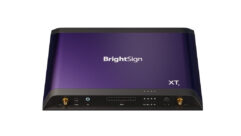
Digital Signage Servers and Players
Feb 1, 2008 12:00 PM,
By Bennett Liles
Hardware to fit any application and budget.

Cisco Digital Media Player 4305G
The digital signage realm is huge, not only in its growing acceptance and implementation in the retail world, but also in the many components and iterations it involves. It appears the industry itself is a breaking wave, with new ideas and applications constantly floating to the surface. While there are many ways you can approach it, in this article we’ll look at the hardware that functions as the source point for deployment of all the creative content flowing to display screens in every imaginable venue. These dedicated playback units exist separately from computer-based signage systems that exist primarily as software applications, although some of the units we will examine are marketed as a package with their own proprietary software.
The media servers and players that store and run the preprogrammed messages of digital signage take many forms and exhibit a wide range of capabilities. It’s safe to say at this point that there is a perfect media player out there for any conceivable application, at a price point that will fit any budget. The challenge is in sorting out the entries in what has become a very competitive field. It helps to know the range of media file types that content creators will provide and the degree of automation that will be needed, as well as to keep in mind possible options for future expansion. There will definitely be a balance to consider between going light on the initial investment and replacing the hardware later or making a more substantial commitment with expansion in mind.
The choices range from relatively simple standalone media players with only local connectivity to centrally located, rackmounted servers that feed programming and scheduling programs to local channel players that store their instructions and play their media in a semi-autonomous fashion. Most players and servers incorporate embedded Windows operating systems, and many of them include software applications that facilitate content authoring, display design, and program scheduling. Remote management is typically via wired Ethernet, Wi-Fi, RS-232 serial ports, and WAN connectivity. The price points for these systems range from a few hundred to several thousand dollars, but they all achieve the aim of delivering scheduled play of multiformat visual — and in some cases sound — content to high-definition displays for dynamic signage.

Codex Novus HD Codex DML-1600
THE FIELD
Adtec Digital offers a very compact hardware device called the DisplayMate, which plays high-definition AVC/H.264 and MPEG-2 media in an auto-scaling mode to fit any display resolution up to 1080i using the included MediaControl scheduling-and-management software. Less than 1.3in. thick, the DisplayMate can attach to the back of a display monitor with the optional DisplayEnvelope VESA mount. A very handy feature of this system is the ability to deploy multiple hardware units and synchronize their playback. External control is interfaced through parallel or serial ports. Depending on flash storage options, the DisplayMate can list from $1,700 to $2,000.
The DSA-3400 from Advantech features an Intel Core2 Duo Mobile processor running Windows XP embedded OS for HD media playback from a 40GB hard drive and two 512MB channels of base memory. The unit features wired or wireless Ethernet connectivity and includes a tuner for integration of TV signals into the display. The DSA-3400 includes four USB ports, TV out, S-Video out, mic-in, line-in, a CompactFlash (CF) card slot, VGA and DVI outputs, and two serial-control ports.
The AMX Inspired Signage system is a complete 3D, dynamic-signage solution featuring content that is generated in the player in realtime by merging files using templates and user data, rather than prerecorded. The system can consist of Inspired Signage player software; the Media Player; Composer (scheduling-and-authoring software); Babel (a data-extraction tool for live data integration and presentation); Inspired Signage Studio (graphic design and template creation); and the Inspired Signage Live Monitor, a remote monitoring and control application. It can deliver display content at 60fps with hundreds of layers. Scheduling for hundreds of players can be sent out on a network simultaneously.
The MediaStar Evolution IP-based video-delivery system from Cabletime has indeed evolved — into its new product, the MediaStar Evolution Digital Signage Player Endpoint — by adding local storage and playback capability through a USB port or PCMCIA hard drive to run MPEG-2/-4 files. The system’s 2GB internal memory can be upgraded to 8GB. The multicore computing engine runs on Linux, and it can display PowerPoint slides, JPEGs, tickers, and HTML pages. With the capability of displaying resolutions of up to 1080i, the Endpoint can respond to external device control via its USB and RS-232 connections.
The MP-02 networked MPEG-playback system from Caltron Industries can store or download MPEG-1/-2/-4, MP3, and JPEG from CompactFlash cards with capacities up to 4GB. The system downloads content from a central networked server via an Ethernet port onto local CF memory, and it schedules it for play on a predefined time schedule using the system’s client-administration tool (CAT). The MP-02 features 2-channel audio playback along with composite, S-Video, or NTSC/PAL VGA output, and it can connect through 10/100 Ethernet or optional Wi-Fi. It includes remote management through web server support.
The SMP-WebPlus from Cayin Technology runs on an embedded Linux platform, and it supports the display of HTML, JavaScript, Flash, DHTML, and CSS content in fullscreen web pages. Users can program HD video, or they can program interactive operation with touchscreens, keyboards, keypads, and a mouse. The Web Manager software application allows content scheduling and remote operation, and the unit can function in either standalone or server-based mode.
Part of the Cisco Digital Media System, the Digital Media Player 4305G is an IP-based unit that plays Flash animations, graphics, and text tickers as a standalone device or as part of an integrated network. Weighing less than 1lb., the 4305G supports HD and SD media playback in MPEG-1/-2/-4 with a 2GB local storage capacity and video data rates up to 12Mbps. The display may be fullscreen or divided into regions for integrated messages. Interface ports include HDMI, USB, Ethernet, RS-232, composite, and S-Video.
The HD Codex DML-1600 networked media player from Codex Novus provides high-definition video and multichannel 5.1 or 7.1 digital audio, still images, and interactive multimedia content with IR, RS-232, and networked computer remote control. The unit features DVI or HDMI video output; 480p-, 720p-, or 1080p-resolution support; digital, coaxial, and optical audio outputs; static or dynamic Gigabit Ethernet addressing; and two USB 2.0 ports. The DML-1600 also offers a massive 1.6TB internal storage capacity and file compatibility with MPEG, AVI, and TS video, as well as MP2, MP3, AC3, WAV, and AAC audio. The list price is $6,999.
The DigiShow Fireblade II multiformat media server delivers JPEG and BMP stills, HTML web pages, AVI, Flash animation, MPEG-1/-2/-4 video, and simple ticker tape (STT). The server can display these formats in multiple simultaneous outputs and multilayered displays using a variety of formats at once without external conversion. Standard features include remote management and dual-channel output, which can be upgraded to 4-channel output. The unit includes 3G processors, V.2 DigiShow software, and internal expansion cards for customization and expandability.
The Digital View ViewStream 200 offers playback of MPEG-1/-2/-4 digital video, analog NTSC/PAL VGA (640×480), S-Video, composite video, JPEG still images, and MP3 digital audio in retail environments. RS-232 control enables touchscreen remote operation and barcode scanning, and a USB port allows up to 8GB CF card storage without physical removal. Play modes include loop, playlist, and manual. Internal CF-card log files can include the dates, times, and tracks that were played. At only $200, the ViewStream 200 is a feature-filled, entry-level product.
The network-ready SA1000 WebDT signage appliance from DT Research combines DVI and VGA video outputs with web-enabled remote-management tools in the form of WebDT Content Manager and WebDT Device Manager software applications. The unit includes support for numerous video formats, still images, Flash, web pages, RSS, and PowerPoint slides for display in multiple screen zones and layers. On wired Ethernet, the SA1000 can automatically shut down and wake from a powered-down state ready for realtime or scheduled playback, and it can push/pull media files from the network.
Electrosonic offers its MS9200P HD player to run a variety of high-definition digital signage. Multiple units can synchronize themselves with frame accuracy, showing seamless transitions between clips running in a loop. Multiple units can also blend their outputs to span an array of display devices in a larger, overall presentation. An internal format converter ensures compatibility between different input sources, and it scales the input signal automatically to match the display device while providing 5.1-channel surround sound. With an IP-based control protocol and 80GB of internal storage, the MS9200P can handle heavy loads of commercial signage.
The FireFly line of digital media players from Focus Enhancements works with the company’s Media Messenger and Dart media-management software to provide up to four separate output delivery channels with WebView browser-based remote or serial control with AMX, Crestron, or Leightronix units. Content can be updated through FTP, HTTP, or multicast. The FireFly MZ multizone digital media player allows separate zones to be set up on the display so that different content can be shown in each zone, including high-resolution video and graphics along with simultaneous scrolling displays.

GDC Technologies SDM-4000 DSR Display Maestro
GDC Technologies offers its SDM-4000DSR Display Maestro as a one-stop digital signage solution. The unit provides four video signals of up to 1920×1080 resolution in three display modes — videowall, assorted, and duplicated — along with four pairs of stereo analog audio. Presentation layouts include picture-in-picture, picture-and-picture, video-in-picture, and video-and-picture. The Display Maestro can accept signals in DSR, DVD, AVI, VCD, MPEG-1/-2/-4, XVID, Flash, and JPEG formats. It manages playlists centrally for all displays or distributed playlists to groups or individual displays. In addition, it can configure multiple units for synchronized playback.
The HDMA 4000 Sync from Grass Valley1,engineered by Canopus, can operate as a standalone unit or as part of multi-unit network arrangement. It updates content via USB or on the network by Ethernet. It can deliver 720p/1080i MPEG-2 video at up to 40Mbps. Up to 32 units may be synchronized for multiple playback, with each unit either showing content on its own screen or paired with other units for 3D displays. Video outputs include component analog on BNC connectors, composite, S-Video, and DVI-D. The system outputs digital audio on coaxial with Dolby 5.1 surround.
The MediaXtreme MX-HDMI player from Keywest Technology combines the functions of the Keywest MX-Editor digital signage composing software and its ability to input a wide range of formats and media file types without the need for external conversion. Users can drag Flash, MPEG-1/-2/-4,H.264, AVI, VOB, computer graphics, crawls, and logos into one of six timelines for previewing, and they can transfer playlists via FTP to produce scheduled, multilayered signage presentations. HDMI output along with two USB 2.0, stereo audio, and RS-232 outputs complement a 200GB hard drive that is expandable to 400GB. The MSRP is $3,995, which includes software for signage authoring and control.
The AV 800 Aavelin SignMate from Magic Box has taken all the capabilities of the AV 400P, and it has shrunk them into a smaller unit. The player can support either 4:3 screens up to 1280×1024 or 16:9 at 1366×768 resolution. It has composite, S-Video, and VGA outputs in NTSC or PAL, and its display can be mounted in either landscape or portrait orientation. The player also has the storage capacity to provide access to more than 10,000 pages of display media, up to four simultaneous crawl lines, smooth transitions, video-in-window, and Flash playback. Serial and Ethernet ports allow remote management and operation. The new AV 800 Aavelin SignMate, just released in January, retails for $3,995.
The Neatware Digital Signage Player Standard is a very small unit running Windows XP on an Intel 64-bit Celeron processor with a 1GB DDR2 memory and a 60GB hard disk. It features six USB 2.0 ports, two SATA ports, one parallel ATA IDE, one serial port, one parallel port, PS2 keyboard and mouse ports, and PCI wireless capability. It allows control through a 10/100 Ethernet connection, and it runs the Neatware Ladybug Player software application with support for WMV HD, MPEG-1/-2/-4, and AVI video files. The MSRP is a super-low $500.
The Periocast StoreCaster/HDMPEG-2 server delivers stored or satellite-downlinked HD-video content over RF links, taking advantage of the FCC mandate that all large HD displays be equipped with a tuner. The multichannel version of the unit can deliver four separate program streams simultaneously. The StoreCaster/HDsupports all ATSC formats, including 720p and 1080i, and it can also convert and remux a DVB-ASI transport stream from any rate to an ATSC-compatible rate. The StoreCaster/HDretails for $5,495, and the multichannel version lists for $14,995.
In December, Real Digital Media announced the release of the Neocast Media Player GS with an embedded Windows XP operating system and support for WMV, QuickTime, MPEG-1/-2/-4, DIVX, VOB, PNG, JPG, GIF, Macromedia Shockwave, and Flash media files. The player allows various display fields to be configured on the screen for different media sources in landscape and portrait modes, and it features support for satellite, cellular, and broadband connectivity. The Neocast media server may serve to deliver content and centralized control to the Neocast media players via the network.
Sony‘s new VSP-NS7 high-definition digital signage player features a powerful processing unit for enhanced HTML and the capability to show Flash and MPEG content in one layout, as well as seamless video switching. Able to display resolutions up to 1280×720, the unit exhibits five-layer playback including bitmap, JPEG, HTML, video, and telop sources. Picture-in-picture capability accompanies a live IP security camera input, and keying enables the placement of a logo over a video display. Two RS-232 control ports make remote management and control possible as well. The VSP-NS7 lists for $2,300.
Teq Digital markets the QikSign VPW-130-series Windows-based digital signage player for standalone, network, or Internet control and operation. The player can show content on up to six simultaneous zones on LCD, plasma, or projector displays. All models include DVI-I, DVI-D, VGA, component, composite, and S-Video outputs with digital display resolution up to 1080i and stereo sound. The VPW-132 offers Gigabit LAN connectivity, while the VPW-131 and VPW-133 add wireless 802.11g compatibility. All units play Flash, MPEG, AVI, JPEG, BMP, web pages, PowerPoint slides, XML, and RSS feeds.
The Carousel Solo 210 player from Tightrope Media Systems is a low-cost, standalone unit with a web-based interface offering one administrator and one user account and a multizone display for Flash, MPEG-2, and other video formats with HD-video output. The unit is so small that it comes with brackets for attachment to the back of an LCD monitor. The accompanying software integrates content creation with event-management functions, and it provides 50 predefined templates and the ability to import PowerPoint slides. Video outputs include VGA, composite, S-Video, and DVI with stereo sound.
Visix offers a digital signage solution that employs a content server to feed networked content to various channel players, room signs, or content publishers. The channel players come in three form factors — the mini and the small (both freestanding), and the popular rackmount model. They use an embedded Windows XP operating system and a firewall supporting both static and dynamic IP addressing. In a 4:3 aspect ratio, the units can display up to 2048×1536 resolution, and in 16:9 they can show up to 1920×1200. All have 80GB hard drives.
The Xstream C340 player from Xstream Solutions is equipped with MPEG-2 decoders for HD playback, and it offers an optional Wi-Fi network card and a PAL/NTSC card for playback of external TV sources. The player can show static graphics, Flash animation, fullscreen video or picture-in-picture, HTML pages and URLs, and optionally, PowerPoint slides. The Xstream player comes with software that enables dayparted playlists and around-the-clock operation. The C340 joins the Xstream CX mini player and the 1RU rackmounted model.
For More Information
Adtech
www.adtechinc.com
Advantech
www.advantech.com
AMX
www.amx.com
Cabletime
www.cabletime.com
Caltron Industries
www.caltronind.net
Cayin Technology
www.cayintech.com
Cisco
www.cisco.com
CodexNovus
www.codexnovus.com
DigiShow
www.digishow.tv
Digital View
www.digitalview.com
DT Research
www.signage.dtri.com
Electrosonic
www.electrosonic.com
Focus Enhancements
www.focusinfo.com
GDC Technologies
www.gdc-tech.com
Grass Valley
www.thomsongrassvalley.com
Keywest Technology
www.keywesttechnology.com
MagicBox
www.magicboxinc.com
Neatware
www.neatware.com
Periocast
www.periocast.com
Real Digital Media
www.realdigitalmedia.com
Teq Digital
www.teqdigital.com
Tightrope Media Systems
www.trms.com
Visix
www.visix.com
Xstream Solutions
www.xstreamsolutions.com
Bennett Lilesis a freelance television production engineer and AV technician in the Atlanta area. He specializes in government video production, distance learning, and videoconferencing.









